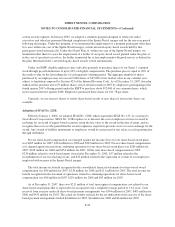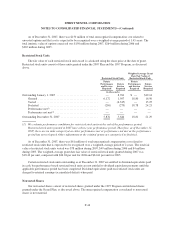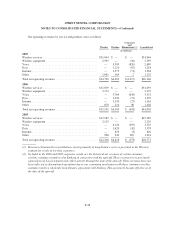Sprint - Nextel 2007 Annual Report Download - page 135
Download and view the complete annual report
Please find page 135 of the 2007 Sprint - Nextel annual report below. You can navigate through the pages in the report by either clicking on the pages listed below, or by using the keyword search tool below to find specific information within the annual report.SPRINT NEXTEL CORPORATION
NOTES TO CONSOLIDATED FINANCIAL STATEMENTS—(Continued)
of the reconfiguration process in most regions, we must cease using portions of the surrendered 800 MHz
spectrum before we are able to commence use of replacement 800 MHz spectrum, which has contributed to the
capacity constraints experienced on our iDEN network, particularly in some of our more capacity constrained
markets, and has impacted the performance of our iDEN network in the affected markets.
The Report and Order requires us to complete the 800 MHz band reconfiguration within a 36-month period,
ending in June 2008, subject to certain exceptions, particularly with respect to markets that border Mexico and
Canada, and to complete the 1.9 GHz band reconfiguration within a 31.5-month period, originally ending in
September 2007 and recently extended, as discussed below. If, as a result of events within our control, we fail to
complete our reconfiguration responsibilities within the designated time periods for either the 800 MHz or 1.9
GHz reconfigurations, the FCC could take actions against us to enforce the Report and Order. These actions
could have adverse operating or financial impacts on us, some of which could be material. We believe, based on
our experiences to date, that the 800 MHz reconfiguration will not be completed within the applicable FCC
designated time period due primarily to circumstances largely outside of our control.
On September 11, 2007, the FCC issued a Third Memorandum Opinion and Order, or Third MO&O, in
which the FCC ordered, among other things, that by June 2008 we vacate many 800 MHz channels that we
currently use, even if the applicable public safety licensee is not ready to relocate to the vacated spectrum. Based
upon reports filed by the 800 MHz TA and discussions with public safety licensees, we believe that a significant
number of large public safety agencies will not be able to complete their reconfigurations by June 2008. Should
this occur, the Third MO&O provides that we would no longer have access to a significant portion of 800 MHz
spectrum.
Any sudden and significant decrease in network capacity that results from the requirements of the Third
MO&O could adversely affect the performance of our iDEN network. To compensate, we could attempt to
construct additional sites or acquire additional spectrum, to the extent possible. In those markets where these
network investments are not possible, we may be required to curtail subscriber additions and incent certain
existing subscribers of iDEN services to use PowerSource devices or move to our CDMA network until the
capacity limitation can be alleviated, particularly if the replacement 800 MHz spectrum is not available for any
length of time. Degradation in network performance in any market could result in higher subscriber churn in that
market. The loss of a significant number of subscribers could adversely affect our results of operations.
We believe that the Third MO&O is not consistent with the terms of the Report and Order or our
understanding of the reconfiguration process described in the Report and Order, which served as the basis under
which Nextel consented to its terms. In addition, we believe that the process by which the Third MO&O was
adopted was legally deficient in a number of respects. Accordingly, on October 12, 2007, we filed an appeal with
the U.S. Court of Appeals for the D.C. Circuit. On November 27, 2007, the U.S. Court of Appeals granted our
Motion for Expedition, setting forth an accelerated briefing schedule which should result in a decision by the
Court by the FCC’s June 2008 deadline. Both the FCC and we have filed our briefs with the Court, and oral
arguments are scheduled to begin March 18, 2008.
In addition, as part of the Report and Order, the reconfiguration of the 1.9 GHz band was required to be
completed by September 7, 2007. On September 5, 2007, we, along with the Association for Maximum Service
Television, Inc., or MSTV, the National Association of Broadcasters, or NAB, and the Society of Broadcast
Engineers, or SBE, filed a joint petition requesting an additional 29 months to complete the transition of the
broadcast auxiliary service, or BAS, to frequencies above 2025 MHz. On November 6, 2007, the FCC granted a
waiver until January 5, 2008 to complete the BAS transition above 2025 MHz. On December 6, 2007, Sprint
Nextel, the MSTV, the NAB and the SBE submitted a consensus plan for completing the transition of the BAS
F-50





















